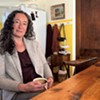Published March 14, 2006 at 9:34 p.m.
BURLINGTON -- The 2006 mayoral election, which featured Vermont's first-ever use of Instant Runoff Voting (IRV), wasn't just a local milestone. It's also being hailed as a successful model for electoral reform for other municipalities and states across the country, according to one expert who helped the city with its implementation.
Caleb Kleppner is a consultant with Election Solutions of New Haven, Connecticut. In December, Kleppner began working with the City of Burlington to design an IRV voter-education campaign and test the software that would tally the results.
"The real story of this election is that it worked incredibly smoothly, more smoothly than I expected," Klepper says. "Voters and poll workers didn't have any problems with it at all."
IRV balloting allows voters to rank their choice of candidates in order of preference. Although critics warned that certain people, such as first-time voters and the elderly, might get confused by the new system, nearly all Burlington voters found the transition an easy one; the city's help desk was quiet all day.
The process of closing down the polling stations at the end of the night was also quick and hassle-free, according to Kleppner. The polls closed at 7 and, by 8:30, election officials were already announcing the ward-level results. By 9 p.m., the mayoral returns were made public. "Poll workers, voters and the media all came to the same conclusion: 'This was easy,'" Kleppner adds.
Burlington's mayoral election was also noteworthy for its unprecedented openness. Anyone with access to an online computer can visit a website -- http://www.burlingtonvotes.org -- to see the electronic record of every vote cast, and examine the software used to count it. Those who question the outcome of the election can also download the raw data and the software and independently tally the votes, then check those results against the paper ballots kept in City Hall. The only information that's not public is the identity of each voter and the proprietary software of Diebold, the manufacturer of Burlington's ballot-scanning machines.
"This is the most transparent election that's ever been conducted in the United States," Kleppner asserts. "You've got an electronic record of every vote, you've got a paper record of every vote, and any member of the public can scrutinize it."
Burlington is only the second city in the nation to use IRV balloting on modern voting equipment -- San Francisco was the first, in 2004. However, IRV is not a new phenomenon in the United States. According to Kleppner, it was first used in municipal elections as early as the 1910s and was a common practice around the country throughout much of the first half of the 20th century.
The advantages of IRV are obvious. Since it eliminates the need for traditional runoff elections, it saves candidates and election officials both time and money. And, the results of IRV are seen as more representative of the will of the people, since voter turnout usually drops considerably in a runoff race.
However, IRV was discontinued for both practical and political reasons. Before the advent of electronic voting machines, IRV ballots could be very time-consuming to tally by hand; in other places, the losing party lobbied for their removal. For instance, Ann Arbor, Michigan, decided its 1975 mayoral race by IRV, only to discontinue it shortly afterwards, when the Republican frontrunner, who had earned 49 percent of the vote in the first round, lost to the Democratic candidate, who had garnered only 40 percent.
Kleppner predicts that Burlington's overwhelming success with IRV will encourage other towns and cities to consider adopting it. "There's growing interest in IRV across the country," he suggests, "but a lot of places didn't want to be the first ones to stick their necks out."
More By This Author
Speaking of...
-

Overdose-Prevention Site Bill Advances in the Vermont Senate
May 1, 2024 -

Aggressive Behavior, Increased Drug Use at Burlington's Downtown Library Prompt Calls for Help
May 1, 2024 -

Reinvented Deep City Brings Penny Cluse Café's Beloved Brunch Back to Burlington
Apr 30, 2024 -

Burlington’s Blue Cat Steak & Wine Bar Closes After 18 Years
Apr 30, 2024 -

Burlington Budget Deficit Balloons to $13.1 Million
Apr 25, 2024 - More »
Comments
Comments are closed.
From 2014-2020, Seven Days allowed readers to comment on all stories posted on our website. While we've appreciated the suggestions and insights, right now Seven Days is prioritizing our core mission — producing high-quality, responsible local journalism — over moderating online debates between readers.
To criticize, correct or praise our reporting, please send us a letter to the editor or send us a tip. We’ll check it out and report the results.
Online comments may return when we have better tech tools for managing them. Thanks for reading.













































